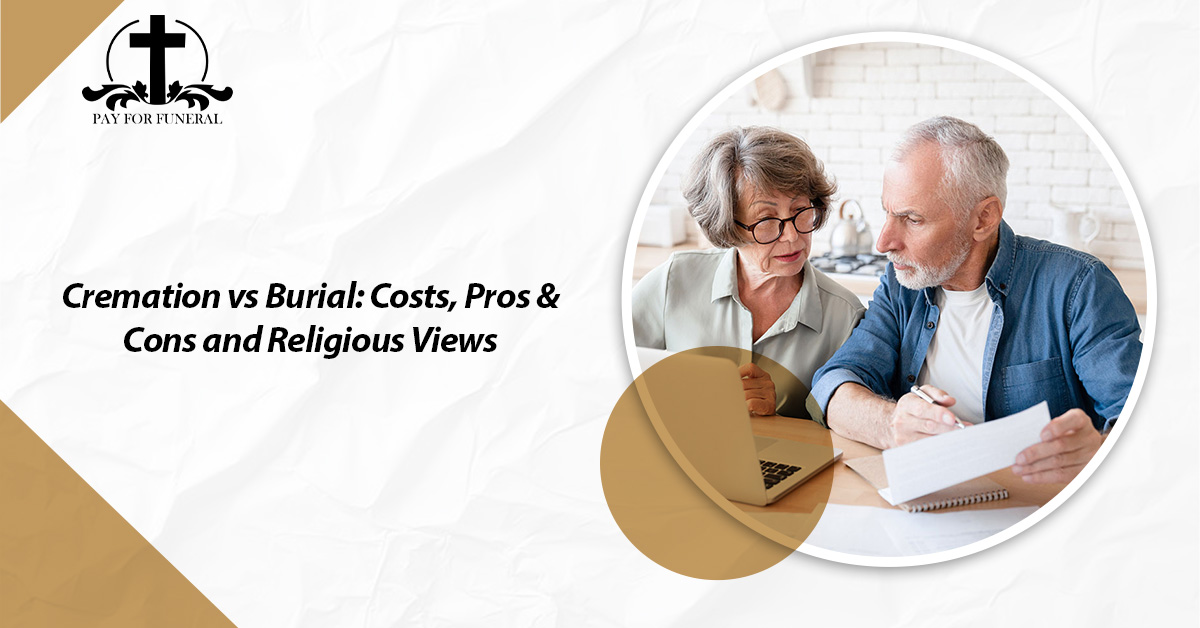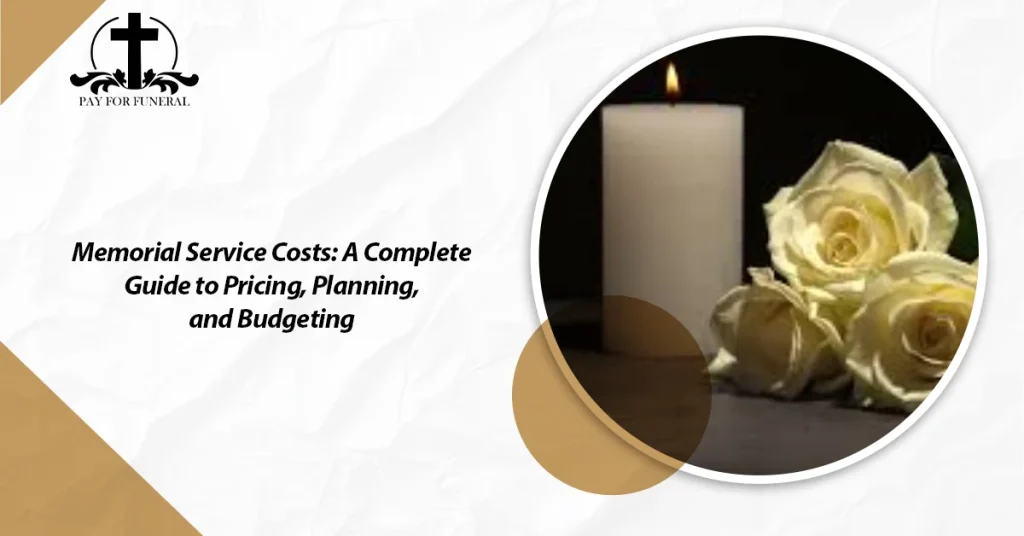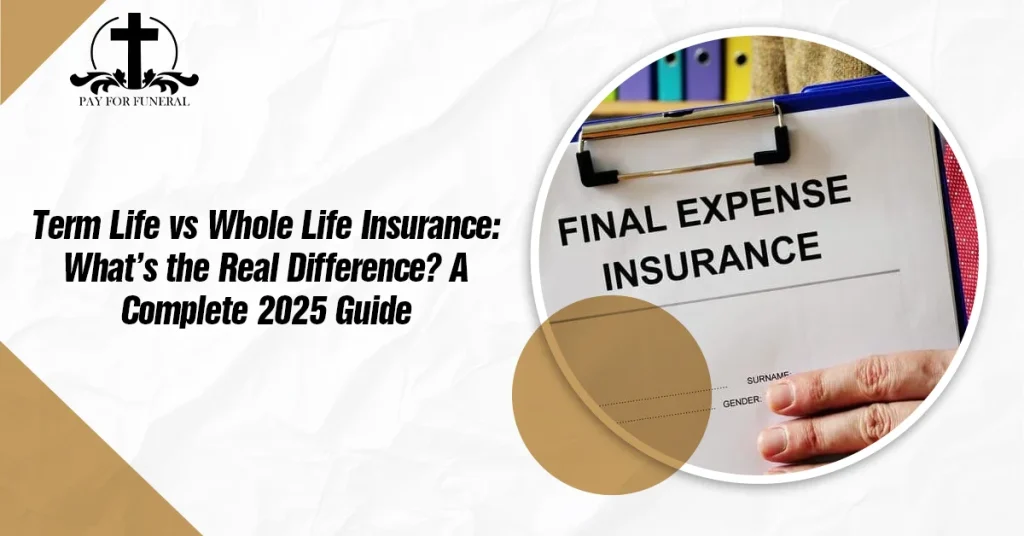Introduction
Saying goodbye to someone we love is never easy. It’s a deeply personal moment, and choosing how to honor their memory is one of the most important decisions we’ll ever make.
This article will help you understand the different options available when it comes to laying a loved one to rest. We’ll look at how much each choice costs, the good and bad sides of each, what different religions and the environment have to say about them, and share some helpful numbers and common questions to guide you in making the best decision for your family.
Cremation vs Burial – An Overview
When it comes to saying goodbye to a loved one, the choice between cremation and burial is deeply personal. Some families follow long-standing traditions, while others consider cost, environmental impact, or religious beliefs. Understanding the differences between cremation and burial can help make this emotional decision a little easier.
Cremation is the process of using high heat to reduce a body to ashes. The ashes, also called “cremains,” are usually placed in an urn and can be kept, buried, or scattered in a meaningful place.
Get Free Quotes
Customized Options Await
Traditional burial, on the other hand, involves placing the body in a casket, usually after embalming, and burying it in a cemetery plot. Burial often includes a full funeral service and a graveside ceremony.
A Brief Look at History
Burial has been the most common practice for centuries in many cultures and religions, especially in the West. Cremation, while long accepted in Eastern cultures, was less common in the U.S. and Europe until the 20th century. Over time, views on cremation have changed, and it is now seen as a respectful and practical option by many families.
Cremation vs Burial: What Do the Numbers Say?
According to the National Funeral Directors Association (NFDA):
- In 2024, the cremation rate in the U.S. is projected to be 61.9%.
- The traditional burial rate is expected to fall to 33.2%.
- By 2045, cremation is forecasted to reach over 80%.
These numbers highlight a clear trend: cremation is now more common than burial and continues to rise each year. This shift is driven by factors like lower costs, fewer religious restrictions, and more flexible memorial options.
Price Comparison – Cremation vs Burial
One of the biggest factors families consider when choosing between cremation and burial is cost. The price of final arrangements can vary widely depending on location, service choices, and personal preferences. Understanding the typical expenses for both options can help you plan ahead and make informed decisions.
Cremation is generally more affordable than traditional burial. Direct cremation, which includes only the basic service without a ceremony, usually costs between $1,000 and $2,500. If you include a memorial service, viewing, or other extras, the total can rise to around $6,000 to $7,000.
In contrast, traditional burial is often more expensive. A standard funeral with embalming, viewing, casket, ceremony, and cemetery plot can cost $7,000 to $12,000 or more. Simplified burial options, with fewer services, may be available for less but are still typically costlier than cremation.
Average Price Comparison
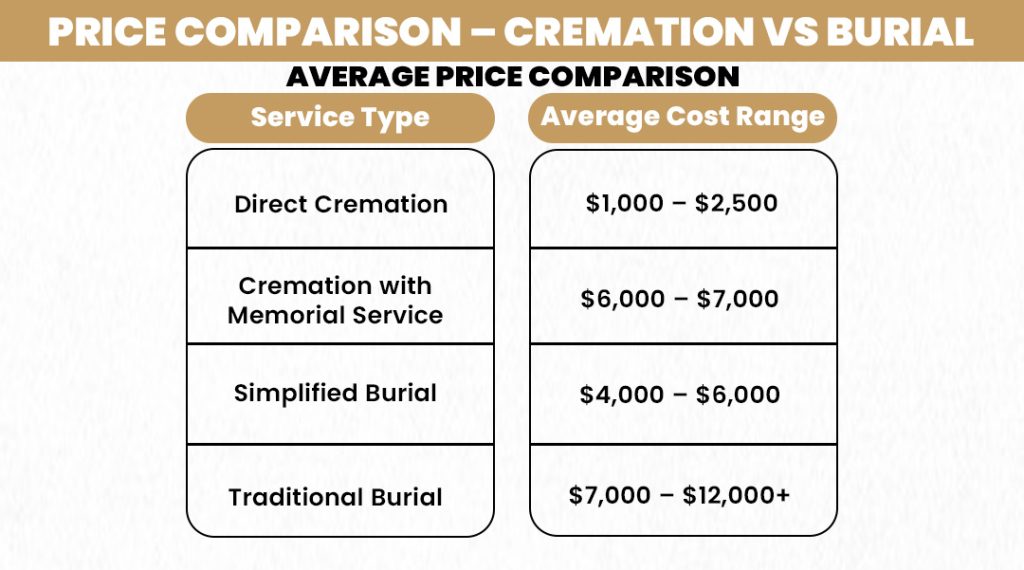
Geographic Variations
Costs can vary depending on where you live. For example:
- In urban areas, prices tend to be higher due to increased demand and overhead.
- In rural regions, both cremation and burial may be more affordable.
- States like California and New York often report higher average funeral costs, while states like Oklahoma or Mississippi typically have lower prices.
Factors That Affect the Cost
Several elements can influence how much you’ll pay:
- Location – Local funeral home fees and cemetery prices vary.
- Type of Service – Direct services are cheaper than full memorial or religious ceremonies.
- Casket or Urn – Caskets can cost thousands, while urns usually range from $50 to $500.
- Transportation – Moving the body from the place of death to the funeral home or cemetery can add extra charges.
- Additional Items – Flowers, printed materials, obituary notices, and headstones also add to the final cost.
In summary, cremation is usually the more cost-effective choice, especially for families looking for simple or flexible options. Burial, while traditional, comes with higher average costs due to caskets, plots, and more involved services.
Cremation vs Burial Pros and Cons
Choosing between cremation and burial involves more than just cost; each option has its own emotional, practical, and cultural considerations. Here’s a clear breakdown of the pros and cons of cremation vs burial to help guide your decision.
Pros of Cremation
- Lower cost – Generally more affordable than traditional burial.
- Flexibility in memorial services – Services can be held before or after the cremation, at any location.
- Less land usage – No need for a cemetery plot unless ashes are buried.
- Simpler process – Fewer steps and arrangements compared to burial.
Cons of Cremation
- Not accepted in some religions – Some faiths, such as Orthodox Judaism and Islam, may prohibit cremation.
- Permanent decision (irreversible) – Once cremated, the process cannot be undone.
- Emotional impact on family – Some family members may struggle with the idea of cremation or feel a lack of closure.
Pros of Burial
- Traditional and ceremonial – Often seen as a more formal, respectful farewell.
- Gravesite for visitation – A physical place for family and friends to visit and remember.
- More widely accepted across religions – Most major religions support burial as a standard practice.
Cons of Burial
- Higher cost – Includes casket, embalming, cemetery plot, and ongoing maintenance.
- Land/resource consumption – Requires physical space and materials like wood, metal, and concrete.
- Long-term maintenance – Headstones and gravesites require care and upkeep over time.
By weighing these pros and cons, you can choose the option that best honors your loved one’s wishes, your family’s needs, and your personal beliefs.
Cremation Process vs Burial Process
Understanding the cremation process vs burial process can help families make informed, respectful choices. While both options honor the life of a loved one, they follow different steps, timelines, and emotional experiences.
Cremation Process – Step by Step
- Authorization and paperwork – Legal consent from next of kin and permits from local authorities are required.
- Body preparation – The body may be cleaned and dressed; embalming is usually not necessary unless there is a viewing.
- Cremation – The body is placed in a cremation chamber and exposed to high heat (1,400–1,800°F) for 1.5 to 3 hours.
- Ash collection – Remains are processed into fine ashes and placed in a temporary container or chosen urn.
- Return of ashes – Ashes are returned to the family for scattering, burial, or keeping.
Burial Process – Step by Step
- Authorization and paperwork – Includes death certificate, burial permit, and consent for embalming or body preparation.
- Body preparation – Typically includes embalming, dressing, and casketing.
- Viewing or funeral service – Can be held at a funeral home, church, or graveside.
- Graveside service – A short ceremony is held before burial.
- Burial – The casket is lowered into a grave, often with a vault, and covered with soil.
Timeframe Comparison
- Cremation: Usually completed within 3–7 days after death, depending on paperwork and crematory availability.
- Burial: Typically takes place within 3–5 days, but may vary based on religious customs or funeral arrangements.
Legal and Procedural Requirements
- Cremation requires additional legal paperwork, including a medical examiner’s approval in many areas.
- Burial may involve cemetery agreements, plot deeds, and arrangements for a burial vault or headstone.
Emotional and Psychological Aspects
- Cremation: May offer flexibility, but some families feel a lack of closure without a physical gravesite.
- Burial: Provides a traditional ritual and a lasting place to visit, which many find comforting during the grieving process.
Both processes are respectful ways to say goodbye. The right choice depends on your family’s beliefs, emotional needs, and logistical considerations.
Eco-Friendly Burial Alternatives
Green Burials
Avoid embalming chemicals and use biodegradable materials, allowing the body to naturally decompose and help preserve ecosystems.
Biodegradable Urns
Made from recycled paper, plant fibers, or other natural materials, these urns break down naturally when buried, reducing environmental impact.
Aquamation (Alkaline Hydrolysis)
Uses water and alkaline solutions to gently break down the body, producing fewer emissions and using less energy than traditional cremation.
Environmental Impact Comparison
Traditional cremation releases about 540 kg of CO₂ per body, while aquamation emits around 90 kg. Green burials avoid chemical pollution and conserve land, making them a much greener choice overall.
Religious Views on Cremation and Burial
Religious beliefs strongly influence how individuals and families make end-of-life decisions. Below is a brief overview of religious views on cremation and burial, including key practices and beliefs from major faiths.
Christianity
- Burial is traditionally preferred, following the example of Jesus.
- Cremation is not forbidden in the Bible, but it was once discouraged.
- Today, many denominations accept cremation if done respectfully.
- Biblical view: “From dust you came, to dust you shall return” supports burial but doesn’t strictly oppose cremation.
Islam
- Burial only – cremation is strictly prohibited.
- The body must be buried as soon as possible, facing Mecca.
- The body is sacred and should not be burned.
- Grounded in Sharia law and Prophet Muhammad’s teachings.
Judaism
- Burial is a religious obligation in traditional (Orthodox) Judaism.
- Cremation is discouraged or forbidden, though some liberal sects may allow it.
- Based on the belief that the body should return to the earth.
Hinduism
- Cremation is the standard practice.
- Belief: cremation helps the soul move to its next life.
- Burial is rare, typically for children or saints.
Buddhism
- Both cremation and burial are accepted.
- Cremation is more common, symbolizing the impermanence of life.
- Practices vary by region and tradition.
Influence on End-of-Life Choices
- Religious teachings guide how people honor the body after death.
- Families often follow faith-based practices for peace and spiritual meaning.
- Respecting these beliefs ensures dignity and cultural sensitivity.
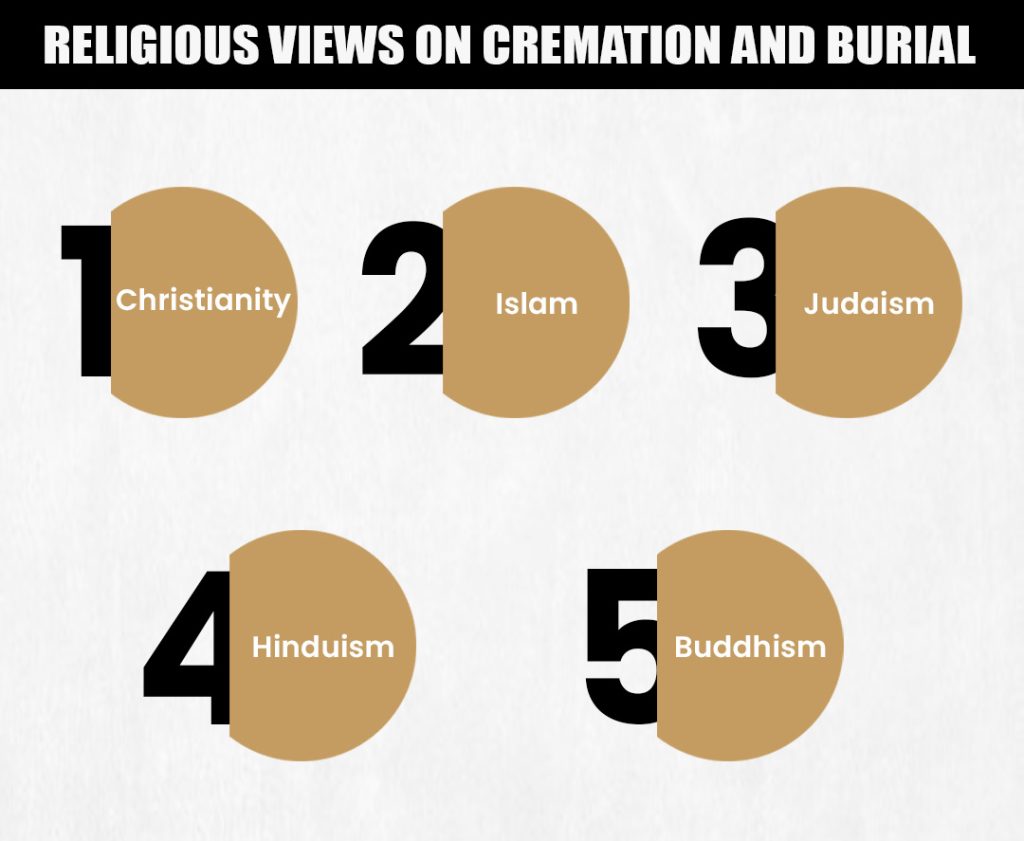
Conclusion
Cremation is generally more affordable and flexible, while burial offers tradition and a physical place of remembrance. Each option carries its own financial, spiritual, and emotional considerations.
Ultimately, the “right” choice depends on your budget, personal values, cultural customs, and religious beliefs.
To avoid stress during difficult times, discuss your preferences early with loved ones or consult a funeral planner to make informed, thoughtful decisions in advance.
FAQs – Cremation vs Burial
Q: How much is cremation vs burial?
Cremation typically costs $1,000–$4,000, while burial ranges from $7,000–$12,000.
You can save by choosing direct cremation or skipping embalming and a formal service.
Q: What is the cost of cremation vs burial?
Direct cremation can be as low as $500–$2,000; a traditional burial can exceed $10,000.
Costs vary by location, service choices, and funeral provider.
Q: What does the Bible say about cremation vs burial?
The Bible doesn’t forbid cremation and focuses more on respect for the body.
Christian views vary, with many modern churches accepting cremation.
Q: Is Cremation Better Than Burial?
Cremation is cheaper and simpler, while burial aligns more with traditional and religious values.The best option depends on your faith, finances, and personal preferences.
Q: What is the cheapest – cremation or burial?
Cremation is usually the cheapest, especially with direct cremation.It avoids costs like a casket, plot, and embalming.

